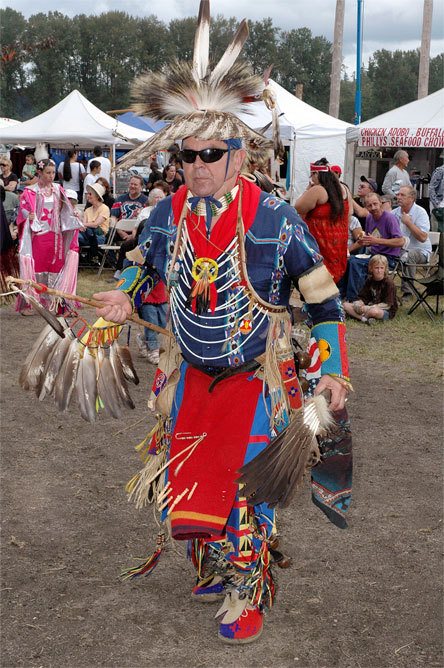ARLINGTON HEIGHTS — This year marked a “fresh start” and record turnout for the Stillaguamish Festival of the River Aug. 8-9.
Stillaguamish Tribe Chair Sandy Klineberger explained that she and the Tribal Council saw the 20th annual Festival and pow wow as an opportunity to refocus on “the traditional culture that’s been missing from the Tribe for the past 30 years,” which the Tribe also did recently by performing its first salmon ceremony in more than 150 years, by Klineberger’s estimate.
“The Festival is a reflection of the Tribe and who we are,” said Klineberger, who cited its tents on both cultural and natural resources. “We have to get our children involved in carving, basket-weaving, gathering of native plants and learning our language.”
To that end, this year’s Festival included a greater focus on its pow wow, which Klineberger sees as a cultural benefit to other tribes and the surrounding community.
“It’s much bigger than it’s been in years past, with many more dancers,” Klineberger said. “We want it to feel welcoming to everyone, and not just the tribes. We’ve had people come and say, ‘Oh, I didn’t go over to the pow wow, because I thought that was just for native peoples,’ but that’s how we show part of who we are. You’re don’t have to dress in regalia to be part of it. It’s a religious ceremony, like being in church, and when you hear that drumbeat, it’s like a heartbeat, celebrating our ancestors and their history.”
Klineberger noted that this year’s pow wow saw increased participation from Stillaguamish Tribal members, and added that the band Train invited pow wow participants to come up on stage with them Aug. 8 and perform one of the band’s songs together.
“We’re never had a musical group who performed here do that for us before,” Klineberger said. “It honored who we are and what we’ve done.”
Arnold Little Head, a Sioux Indian living in Portland, Ore., has served as the Festival’s pow wow announcer for several years, and he echoed Klineberger’s perceptions of its growth over the years.
“We’ve got a wide variety of dancers and drummers here from more than 150 different tribes,” said Little Head, who listed the participants’ locations of origin as including Canada, Oregon, California, Idaho, Montana, Utah, Arizona, Oklahoma and the Great Lakes region. “This is one of the biggest pow wows since I’ve started here. It’s traditional, you don’t have to compete, and you can dance, share some food and a few laughs, and enjoy each other’s company. The Stillaguamish people always treat us really well and make sure that everyone leaves with a little something, to show their appreciation.”
Stillaguamish Tribe Fisheries Manager Shawn Yanity recalled that last year’s Festival drew a total of 11,000 attendees for both days, but estimated that this year’s Festival had already drawn 8,000 attendees on its first day. Between first-day attendees returning the second day and other attendees only showing up for the second day, he estimated that this year’s two-day total would probably hit 13,000, a number which necessitated the designation of an entirely new parking area on the grass this year.
“We’ve had steady traffic coming in and out of here both days,” Yanity said. “A lot of folks are just enjoying the days, with their wonderful weather this year, while others are also celebrating the watershed and the different cultures here. There aren’t that many community events that are this large and still have free parking and no entry fees.”
Yanity was excited to talk about this year’s cultural resources tent which added exhibits on carving, weaving and drum-making, and featured a hands-on informational display on the Tribe’s bison herd.
“We’ve got a buffalo box,” Yanity said, opening a container made from buffalo hide, “plus a bladder that’s a water container, a bone knife, a sample of sinew and a horn cup. I have a buffalo knuckle pipe at home that’s quite beautiful. People hear that we even use the scrotum, and the guys go, ‘Ew,’” he laughed.
Yanity pointed to displays of stone tools, grasses that were woven into baskets, and cedar that on-site demonstrators were carving into toy rattles and miniature paddles, and weaving into crowns for the pow wow princesses.
“This lets people see how much craft its takes to make these things,” Yanity said. “You didn’t have modern sanders when you worked the wood back then. You had to let the wood guide you. You couldn’t just make a drum by stretching hide over it, because it would be too tight. Those drums were what elevated and carried our songs. We want people to see that this was what sustained us, and was part of our everyday lives. Just listen,” he said, gesturing to the carving and weaving areas under the tent. “You can hear the conversations. The women are all talking and joking. When the carvers and weavers got together, it was a time of fellowship and carrying on tradition.”
Festival attendees expressed their appreciation for both the cross-cultural experience and the entertainment of the event.
Click here for more photos.







